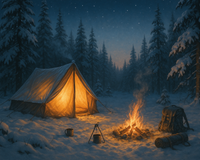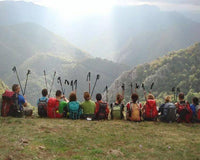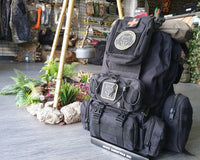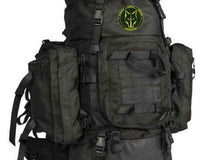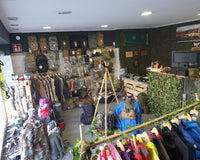 How to Prepare for Extreme Winter: Northvivor's Guide to Survival, Endurance, and Outdoor Gear
How to Prepare for Extreme Winter: Northvivor's Guide to Survival, Endurance, and Outdoor Gear
Winter isn't the same everywhere. In some regions, it's barely a chilly breeze; in others, like Norwayor Russia, the cold can reach levels that can freeze steel and willpower.
At Northvivor, we believe that preparation is the line between discomfort and survival.
Whether you live in Spain, the mountains of the USA, or the frozen environments of the North, this guide will show you how to face winter with a prepper's mindset, bushcrafttechnique, and gear designed to withstand what others can't.
1. Know your terrain and plan like a true Northvivor
Winter demands strategy. Each environment offers its own version of the challenge:
-
In Norway, sub-zero temperatures and Arctic winds put technical clothing to the test.
-
In Russia, ice covers roads for weeks, and self-sufficiency is vital.
-
In Spainand the USA, cold waves arrive with less warning, but they can collapse basic services.
Northvivor Tip:Your best defense isn't a coat, it's knowledge. Assess risks, prepare your emergency plan, and stock your backpack with essentials before the first snowfall.
Northvivor Tactical Poncho for Extreme Winter - Professional Survival Gear
2. Dress to beat the cold: layers that will withstand the Arctic
It's not just about keeping warm, it's about creating a smart barrier against extreme cold.
Inspired by Nordic environments and Russian military discipline, our clothing systems combine thermal technology and tactical durability:
-
Northvivor Base Layer:Moisture-wicking and warm even at -20°C.
-
Mid-layer:thermal insulation inspired by Scandinavian expeditions.
-
Outer layer:Jackets with waterproof and windproof fabrics that have been tested in conditions comparable to those of the Arctic Circle.
Northvivor Recommendation:Our winter tactical glovesand thermal socks made of natural woolkeep your body temperature stable even in snowstorms.
3. Warmth and shelter: when winter turns hostile
In areas like Siberia or the Norwegian fjords, staying warm is a matter of survival.
Therefore, shelters must be efficient, compact and reliable.
-
Create a safe zone: Use thermal blankets, floor mats, and portable stoves.
-
Practice ancestral fire:learn to light a flame with flint, magnesium, or Northvivor firestarters.
-
Avoid gas poisoning:Always ventilate your closed spaces, even in extreme conditions.
Northvivor gear tested in real-world conditions: compact stoves, fire blankets, and bushcraftfire kits. Proven to withstand temperatures down to –35°C.
4. Nutrition and energy in extreme cold
When the temperature drops, the body needs more fuel.
-
Prioritize foods rich in protein and fat(nuts, dehydrated meat, caloric soups).
-
Preserves MRE rations or freeze-dried meals : light, durable and ready to eat.
-
Ensure a constant source of drinking waterby using built-in filters or purification tablets.
Northvivor Tip:Our tactical hydration kitsare inspired by the gear used by Scandinavian explorers. Designed to keep your water supply even in sub-zero climates.
5. Security and autonomy: winter's allies
Storms and blackouts are inevitable in deep winter.
-
Keep headlamps, batteries, an emergency radio, and multi-tools.
-
If you go to the mountains, take a GPS, compassandphysical map.
-
Learn first aid for hypothermia and frostbite
NorthvivorEssentials Kit :Multi-function knife, paracord, magnesium lighter, and thermal blanket. Tested in Arctic climate simulations.
6. The Northern mentality: preparation and temple
Extreme cold not only freezes bodies, it also tests the mind.
At Northvivor, we follow the philosophy of the harshest regions on the planet:
-
From Norway,precision and calm in the face of the unpredictable.
-
From Russia,strength and resilience under pressure.
-
From the USA and Spain,adaptability and innovation.
Together, these influences define what it means to be Northvivor:
"Being prepared isn't fear. It's respect for nature and self-confidence."
Conclusion: winter is not feared, it is mastered
From the snowy mountains of Norway to the frozen steppes of Russia, the cold has forged the toughest.
With Northvivor gear, you too can face winter with confidence, intelligence and power.
Our portfolio combines tactical technology, tested materials, and design designed to survive, endure, and thrive.
Explore the Northvivor Winter 2025 collection
Survival, bushcraftand outdoorequipmenttested in the most extreme conditions in Spain, the USA, Norway and Russia.
"Because the cold isn't an enemy... it's a test. And at Northvivor, we're ready."
 Snowy mountain summit with EU, Spanish, and North American flags - Extreme Winter Survival Gear - Complete Outdoor Guide
Snowy mountain summit with EU, Spanish, and North American flags - Extreme Winter Survival Gear - Complete Outdoor Guide
Frequently Asked Questions about Extreme Winter Survival | Nortevivor
What temperature is considered extreme winter?
Extreme winter is considered when temperatures consistently drop below -15°C, with wind chills reaching -30°C or lower. Under these conditions, hypothermia can set in in less than 30 minutes without proper equipment. That's why having Northvivor thermal clothing and survival gear makes all the difference.
What is the basic equipment essential for winter survival?
Essential winter survival gear includes: three-layer thermal clothing (base layer, insulation, and waterproof outer layer), a sleeping bag rated for -20°C or colder, an emergency shelter, a fire system (fire starter, flint, and kindling), a multi-tool knife, a first aid kit, a headlamp, and high-calorie food. Never leave without these Northvivor prep essentials.
How to avoid hypothermia in extreme conditions?
To prevent hypothermia: keep your clothing dry, layer properly, avoid excessive sweating, protect your head and extremities (you lose up to 40% of your body heat through your head), eat energy-boosting foods, hydrate with warm fluids, and seek shelter at the first signs of extreme cold. Northvivor thermal clothing is designed to retain warmth in arctic conditions.
What is the difference between regular outdoor gear and military tactical gear?
Military tactical gear is manufactured to the highest standards: ultra-durable materials, guaranteed functionality in temperatures down to -40°C, MOLLE compatibility, and tactical camouflage colors. It's ideal for preppers, bushcrafters, and true survivalists. Northvivor tactical gear combines military durability with outdoor ergonomics.
How much food should you bring for a winter expedition?
During a winter expedition, the body needs between 4,000 and 6,000 calories a day (twice as much as under normal conditions) to maintain body temperature. Bring high-calorie foods such as nuts, chocolate, energy bars, freeze-dried foods, and healthy fats. Plan on a minimum of 1 kg of food per day plus an additional 30% in reserve.
Is a natural shelter or a tent better in extreme winter?
It depends on the context. A natural shelter, such as a snow cave or igloo, offers excellent thermal insulation, but requires time and experience. A 4-season tent is quicker to set up and provides immediate protection. Ideally, you should master both techniques and always carry a Northvivor tent as a reliable backup.
What bushcraft techniques are most useful in winter?
Key winter bushcraft techniques include: building snow shelters, starting fires with wet materials, purifying water by melting snow, selecting dry firewood, making snow rescue signals, and navigating without a compass. Practice these skills before you need them—training is key for any Northvivor.
How to purify water in freezing conditions?
Never consume snow directly, as it lowers body temperature. Melt it in a metal container and boil the water for 3-5 minutes to eliminate pathogens. You can also use portable filters or purification tablets designed for low temperatures. Store purified water in Northvivor insulated thermoses to prevent it from freezing.
Which thermal clothing is better: synthetic or down?
Natural down offers a better warmth-to-weight ratio and is ideal for cold, dry climates. Synthetic materials maintain insulation even when wet, perfect for humid environments. In extreme winters, the ideal combination is a synthetic base, a down midlayer, and a waterproof synthetic outer. This is Northvivor's thermal efficiency formula.
How long can I survive in extreme winter without equipment?
Without proper equipment, survival is measured in hours, not days. The basic rule of survival is: 3 minutes without air, 3 hours without shelter (in extreme cold), 3 days without water, and 3 weeks without food. At -20°C, without shelter or thermal clothing, fatal hypothermia can set in in less than 90 minutes. That's why at Northvivor we believe that preparation isn't optional—it's vital.




